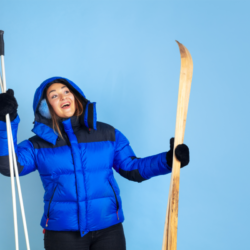To prevent winter ailments, it’s essential to keep your feet warm. Wrapped up in woollen socks or curled up in comfortable slippers, your feet will stay protected from the cold. However, the drop in temperature often leads to dry skin. So how do you combine warmth and hydration for pampered feet all winter long? This article reveals some effective tips.
Did you know that the effects of the cold on our feet go far beyond mere discomfort? Recent studies have shed scientific light on the sometimes little-known consequences of exposure to the cold on our overall health, particularly cardiovascular and metabolic health.
The scientifically proven effects of cold on our feet
Recent research reveals how exposure to the cold affects not only the comfort of our feet, but also our metabolic and cardiovascular health.
Impact on metabolism and cardiovascular health
One study has shown that the thermogenic response in our extremities, such as the feet, can influence the accumulation of body fat, particularly in the abdomen. In addition, exposure to cold has been identified as a significant risk factor for cardiovascular disease, with impacts varying according to climate.
The importance of thermal protection
Keeping our feet warm is not just a question of comfort. Choosing the right footwear with good thermal insulation is crucial for effective protection against the cold. Moisture and movement in unsuitable footwear can reduce this protection by up to 45%. (1)
Who feels the coldest feet?
When temperatures fall, some people seem more prone than others to feeling cold feet. This difference in sensitivity can be explained by several factors, some of which are supported by recent scientific research.
- Gender and cold sensitivity: Studies show that women are generally more likely to suffer from hypersensitivity to cold in the extremities, such as the hands and feet. This condition has a significant impact on quality of life, especially during the winter months. (3)
- Body Mass and Thermogenic Response: Research indicates that individuals with lower body mass may have increased sensitivity to cold. The thermogenic response in the extremities may be linked to the accumulation of body fat, particularly in the abdomen, thus influencing the sensation of cold feet.
- Health conditions: Certain medical conditions can increase sensitivity to cold. For example, people suffering from circulatory disorders, such as Raynaud’s syndrome, may experience a more intense sensation of cold in the feet due to reduced blood flow.
- Age: With age, blood circulation can become less efficient, leading to greater sensitivity to the cold. Older people may therefore feel the cold in their feet more intensely than younger people.
- Lifestyle: Lifestyle can also play a role. People who are less active or who spend long periods sitting down may have less dynamic blood circulation in their extremities, increasing the sensation of cold feet.
By understanding these factors, we can better adapt our habits and clothing choices in winter to keep our feet warm and comfortable. It’s important to choose the right shoes and socks, and to engage in regular physical activity to stimulate blood circulation.
Moisturiser: your winter beauty ally
When winter rolls around, feet and hands are the most exposed to the elements:
- Wind
- Frost
- Snow
They need theright protection to avoid a cold snap. So to keep your skin healthy, even if it’s trapped in fur gloves and slippers, it needs to bemoisturised and deeply nourished.Special creams for cold feet are available from chemists .
Using moisturising products is entirely advisable to keep your feet well hydrated in winter. Even in our lined slippers, the skin will remain supple and elastic. Moisturising helps to firm the epidermal tissues and stimulate blood circulation. And the warmth obtained in socks like the AIRPLUS Cabin Socks will help maintain the effect of this hydration.
An essential oil bath to keep your feet warm in your socks or slippers
Of course, you can just put your feet on the radiator for a few minutes to warm them up before putting on your shoes. But that won’t give your skin the moisture it needs. Moisturising your feet while keeping them warm is areal challenge this winter. But rest assured, it can be done. Nothing could be simpler than an essential oil bath. Unlike the simple heat of a radiator, an essential oil bath provides the warmth and hydration your feet need.
Not only do essential oils help to stimulate blood circulation, they can also bring a feeling of radiance and well-being to the soles of the feet. Ask your naturopath or pharmacist for advice on which essential oils are suitable for use in the bath. Then put on your slippers and socks.
How to make an essential oil bath for foot well-being in winter
In winter, feet are particularly vulnerable to cold and dryness. An essential oil bath can be an excellent way to pamper them, combining deep hydration with a comforting sensation of warmth. Here’s how, using specific products like those from Dr Valnet, which are available from our online pharmacy.
Step 1: Preparing your bath with Alg-Essences by Dr Valnet
To begin with, prepare your bath by adding Alg-Essences Bain Thalasso by Dr Valnet. This product combines seaweed with a complex of organic essential oils (rosemary, lavandin, turpentine, pine, sage, eucalyptus globulus, thyme) for a circulatory and relaxing effect. Seaweed, harvested in Brittany, provides remineralising and relaxing benefits.
Step 2: Using Dynarome for the legs
After bathing, apply Dr Valnet’s Dynarome to your legs for additional care. This product, rich in organic essential oils, improves circulation, relieves leg heaviness and provides a sensation of freshness.
Step 3: Optimisation with Dr Valnet Bath Base
For an optimal experience, use Dr Valnet’s Bath Base, specially designed to dilute essential oils in water. This non-foaming base, derived from castor oil, ensures an even dispersion of the essential oils, maximising their beneficial effects.
Tips for a successful bath
- Water temperature: Make sure the bath water is at a comfortable temperature, neither too hot nor too cold.
- Duration: Stay in the bath for around 15 to 20 minutes to allow the active ingredients to work effectively.
- Frequency: An essential oil bath can be taken once or twice a week during the winter for optimum results.
By making these essential oil baths part of your winter skincare routine, you can give your feet and legs the care and protection they need during this harsh season.
Choice of essential oils
For a comforting and beneficial foot bath, certain essential oils are particularly suitable:
- Eucalyptus Globulus: Known for its refreshing and revitalising properties, it stimulates circulation and provides a feeling of warmth.
- Rosemary: Has a toning effect on blood circulation and can help relieve tired feet.
- Lavender: Offers relaxing and soothing properties, ideal for relaxing foot muscles.
- Pine: Helps improve circulation and provides a sensation of warmth, useful for cold feet.
Foot massage to keep your feet warm this winter
To avoid skin lesions caused by the winter cold, it’s advisable to keep your feet and hands well covered. Wear thick shoes, socks andslippers to keep your feet at a comfortable temperature all day long. And don’t forget to massage them regularly. Massaging the soles of your feet, working up towards your ankles, is a great way to spread warmth, especially when accompanied by a moisturising or heating cream. Simple steps to keep your feet warm and moisturised this winter. As well as dressing appropriately, regular massage of the soles of the feet, using circular movements and moving up towards the ankles, can stimulate circulation and spread warmth.
Finally, this massage, especially when performed with a moisturising cream, reinforces hydration while providing warmth.
As the studies quoted in our article emphasise, protection against the cold is essential. Opt for well-insulated socks and footwear. And don’t forget to keep your feet moisturised, which is crucial to maintaining healthy skin in winter.
References
- https://pubmed.ncbi.nlm.nih.gov/27150642/
- https://pubmed.ncbi.nlm.nih.gov/28279166/
- https://pubmed.ncbi.nlm.nih.gov/12078965/







